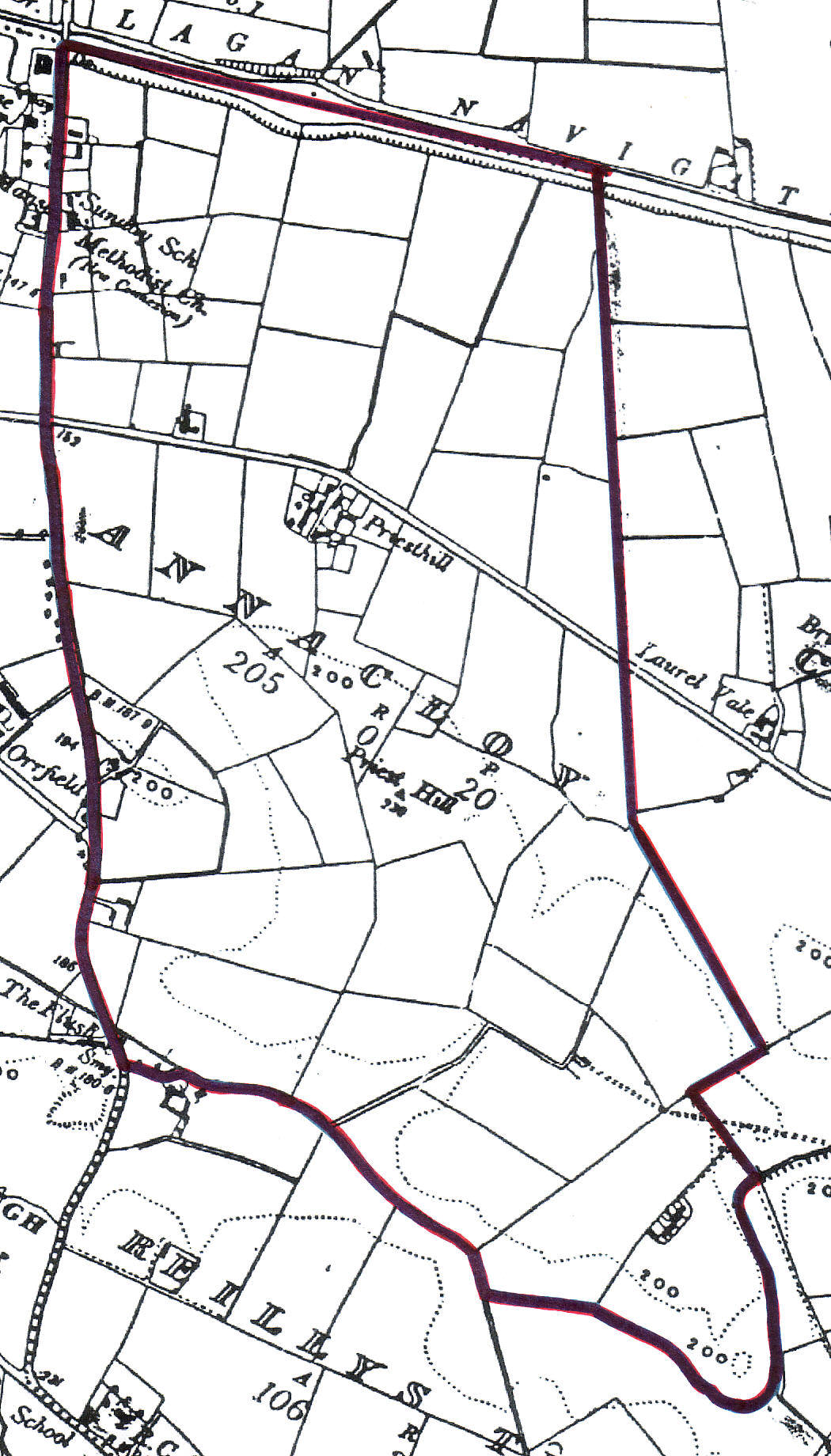
Click for larger view
Parish of Blaris
Annacloy Townland

1782 Location of
Thomas Bradshaw house
FOURTH GREAT GRANDFATHER, Thomas Bradshaw was born in Annacloy and died in Blaris, County Down, Northern Ireland. About 20 miles southwest of Belfast.
He was married to Susannah Woods sometime before 1778.
About 1786, Thomas Bradshaw's home was used as a Preaching-House for early Methodist preachers.1
- Transfer of Annacloy Land Leases2
- Plot # 1, 17th September 1716 - Lease signed by Alice Smith, widow & Henry Smith. PRONI Reference: Kilwarlin Papers D/671/LE8/3/4
(Pre 1716 the land was leased by Robert Young)
....during the natural life of and lives of Thomas Bradshaw son of John Bradshaw of Aghnacloy aforesaid dec and son-in-law of the Alice Smith and of Richard Smith son of Henry Smith aged about five and twenty years and of Robert Smith son of Arthur Smith late of Aghnacloy aforesaid dec aged about one and twenty year and the survivors and survivor of them, the said Alice Smith and Henry Smith their heirs and assigns....- Plot # 1 (Original Lease date May 1716)
1762 - 1766, Richard Smith & Thomas Bradshaw (D/671/A1/28)
(Area: 24 acres, 2 roods, 8 perches) It should be noted that Richard and Thomas are not the original lessees but rather the named lives.
"The country between Lisburn and Moira is much like Berkshire, having fruitful vales in each side of the road, and well wooded hills running even with them, at a small distance."
1The people in the district were afraid of incurring the displeasure of their landlord, the Earl of Hillsborough, who shortly afterwards became the first Marquis of Downshire. During the previous decade he had restored the beautiful church at Hillsborough at his own expense. After some hesitation Thomas Bradshaw of Puddledock Road allowed his home to be used for meetings, and in a little time he also opened the door of his heart to Christ. Later, his wife and some of his family were converted to God. Patrick relates: "In this place we soon saw the fruits of our labour; several were awakened to a sense of their danger ... we joined them in a class, and gave every assistance in our power. Whenever we met together we felt the Divine Presence was with us.... There was soon a change observable in the neighbourhood, the most flagrant sinners became honest, sober and peaceable. Instead of dancing, gambling and quarrelling, the worship of God was set up in their houses; instead of blaspheming the name of God, they were singing His praises. . . . From my first entrance amongst them, I endeavoured to give them an exhortation as often as possible. I made no pretensions to systematic divinity, but spoke about the most familiar things, and was not afraid to mention hell and damnation. I wanted them not only to see the truth, but also to feel its divine force. "The class soon grew so large that we had to divide it, and in a little time we had three classes. I now requested Joseph Cherry to come and help me. . . . He could clothe his ideas with a fine diction, and had a graceful delivery; and his discourse received additional advantage, from a gravity and solemnity almost peculiar to himself. But at the time I spoke to him, he had lost some of his zeal . . . he refused to come. . . . At last he consented to come and assist me, and his coming was not in vain. He soon caught the divine flame that was kindled at this place, which consumed his dead formality, and made him a burning, as well as a shining light. . . . The Lord continued to prosper His work among us, our numbers increased, and the people grew in grace; in a little time we had five classes, consisting of about sixty members." It now became necessary to erect a preaching-house, and this was built on a site close to Thomas Bradshaw's home. It was a simple structure with mud walls and a thatched roof, like many of the homes in the district. The windows were small-paned and leaden, the floor was earthen, and forms were used for seating. The approach from the road was via a narrow lane.
Priest Hill Historical map with Methodist Meeting House
Thomas was one of thirty two stewards and leaders expelled about 1798 for wanting more voice in governing of the Methodist churches.